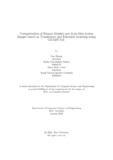| dc.contributor.advisor | Hossain, Muhammad Iqbal | |
| dc.contributor.advisor | Rahman, Rafeed | |
| dc.contributor.author | Hassan, Ibne | |
| dc.contributor.author | Tahsin, Raida Mobashshira | |
| dc.contributor.author | Toma, Sadia Shara | |
| dc.contributor.author | Utchhash, Tausif Tazwar Quadria | |
| dc.date.accessioned | 2023-12-31T05:17:15Z | |
| dc.date.available | 2023-12-31T05:17:15Z | |
| dc.date.copyright | 2023 | |
| dc.date.issued | 2023-01 | |
| dc.identifier.other | ID 22241121 | |
| dc.identifier.other | ID 19101272 | |
| dc.identifier.other | ID 19101016 | |
| dc.identifier.other | ID 19101022 | |
| dc.identifier.uri | http://hdl.handle.net/10361/22041 | |
| dc.description | This thesis is submitted in partial fulfillment of the requirements for the degree of Bachelor of Science in Computer Science, 2023. | en_US |
| dc.description | Cataloged from PDF version of thesis. | |
| dc.description | Includes bibliographical references (pages 67-70). | |
| dc.description.abstract | As the world keeps healing from the worldwide outbreak of COVID-19, the MPOX
virus poses a new risk. The Mpox virus is not as deadly or contagious as COVID-19,
but new patient cases are recorded every day from a wide variety of nations.Therefore,
it will not come as a surprise if another global pandemic occurs due to a lack of pre-
cautionary measures. Therefore, it is essential to detect them before they spread
throughout the community. The World Health Organisation (WHO) has issued nu-
merous precautionary warnings regarding MPOX. If MPOX spreads swiftly, it poses
a significant threat to public health. The result is a significant increase in hospital
wait times. This means that hospitals require additional supplementary or auxiliary
systems.Recent advances in machine learning have demonstrated immense promise
for diagnosis based on image data, including detection of cancer, identification of tu-
mour cell, and identification of COVID-19 patients. Therefore, identical technology
could possibly be used to detect the human skin infection known as MPOX. After
acquiring an image it can be utilised for further diagnosis and early identification of
MPOX.In this research, we leverage 13 recently developed deep learning (DL) mod-
els to suggest a new strategy for enhancing the accuracy of MPOX image detection
and classification. Eight of the suggested models are based on transformer, while the
remaining five are CNN-based models that have been pre-trained.The publicly avail-
able Monkeypox Skin Images Dataset (MSID) is utilized to evaluate the suggested
method. Four standard metrics—precision, accuracy, F1-score and recall —were
applied to the outcomes after the models were fine-tuned. We ultimately utilised an
ensemble approach to enhance overall performance and obtain more precise results.
We achieved the best results possible with our approach, which included a 99% F1
score, 99% accuracy, 100% precision, and 99% recall. Based on these promising out-
comes, which surpass those of existing methods, we propose applying the suggested
method for widespread testing by health practitioners. This model can be used as
a supplementary diagnostic system for the early detection of MPOX skin lesions. | en_US |
| dc.description.statementofresponsibility | Ibne Hassan | |
| dc.description.statementofresponsibility | Raida Mobashshira Tahsin | |
| dc.description.statementofresponsibility | Sadia Shara Toma | |
| dc.description.statementofresponsibility | Tausif Tazwar Quadria Utchhash | |
| dc.format.extent | 70 pages | |
| dc.language.iso | en | en_US |
| dc.publisher | Brac University | en_US |
| dc.rights | Brac University theses are protected by copyright. They may be viewed from this source for any purpose, but reproduction or distribution in any format is prohibited without written permission. | |
| dc.subject | Covid-19 | en_US |
| dc.subject | Pathogens | en_US |
| dc.subject | Symptoms | en_US |
| dc.subject | Monkeypox | en_US |
| dc.subject | CLAHE | en_US |
| dc.subject | GRADCAM | en_US |
| dc.subject | Ensemble learning | en_US |
| dc.subject | Transformer based models | en_US |
| dc.subject | Pre-tained models | en_US |
| dc.subject.lcsh | Cognitive learning theory | |
| dc.subject.lcsh | Pattern recognition systems | |
| dc.subject.lcsh | Machine learning | |
| dc.title | Categorization of human monkey-pox from skin lesion images based on transformer and ensemble learning using GRADCAM | en_US |
| dc.type | Thesis | en_US |
| dc.contributor.department | Department of Computer Science and Engineering, Brac University | |
| dc.description.degree | B.Sc. in Computer Science | |

